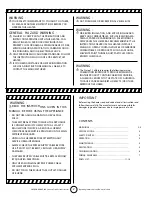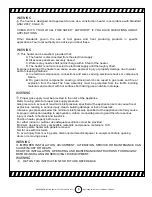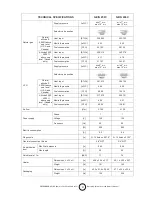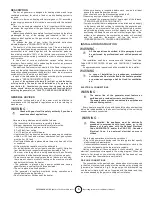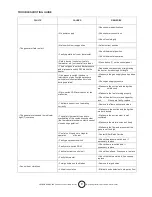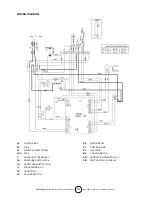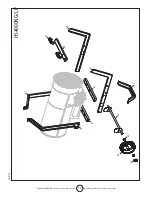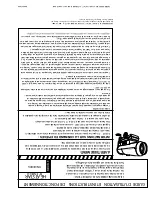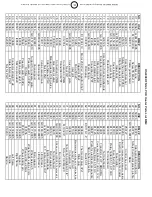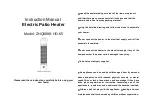
6
Operating Instructions and Owner’s Manual
ENERCO GROUP, INC. |Indirect Fired Portable Heater
DESCRIPTION
The hot air generator is designed for heating medium and large
ventilated premises, for which a fixed or mobile heating system is
required.
Heater is to be run on heating with natural gas or L.P.G. according
to gas supply pressures that must be in conformity with the national
laws.
Gases to be used are indicated in Tab. I together with the supply
pressures, the regulation of the gas valves group (burner pressure)
and gas flow.
Heater is supplied after a complete functional test and it’s therefore
prearranged for one of the working gas indicated in Tab. I: an
adhesive label applied on the gas selector valve (a) indicates the
selected gas.
To change the type of gas, follow the detailed instructions
indicated in section “CHANGING TYPE OF GAS”.
The heater is of the direct combustion type. The air is heated by
the energy developed during combustion and then conveyed to the
environment to be heated together with the combustion products,
thus making available 100% of the thermal power produced. The
environment must be suitably ventilated in order to ensure adequate
air circu-lation.
In the event of serious malfunction various safety devices
(electronic flame control unit, overheating thermostat, air pressure
switch) trigger turning off the heater .
The electronic flame control unit monitors if the flame is irregular or
goes out, the safety thermostat triggers when the temperature in the
combustion chamber exceeds the safety limit value, the air pressure
switch will cut in if the airflow is insufficient.
In each of the said cases the unit stops according to the procedure
described in “OPERATING INSTRUCTIONS”.
In
each
of the said cases the lamp (8) will light up and the heater
will stop working. The heater can be restarted only by pressing the
reset button (8). Nonetheless, the cause that triggered the safety
device should always be carefully analyzed and resolved before
restarting the generator (cfr. “FAULTS, CAUSES AND REMEDIES”).
GENERAL ADVICES
Installation, setting and use of the heater must be effected in
accordance with the applicable regulations and laws relating to
machine use.
Check with
your
local fire safety authority if you have
questions about applications
Here are a few guidelines which shall be followed:
•
The instructions in this manual are carefully followed;
•
Minimum clearances from combustible material must be:
1 m (3 feet) from side and rear (air inlet) of heater
0.7 m(2 feet) from ceiling
3 m (10 feet) on air outlet of heater.
•
Heater shall not be directed toward any propane-gas container
within 6 m (20 feet) and minimum clearances from gas cylinder
must be 3 m (10 feet)
•
Don’t install the heater in places where there may be a risk of fire
or explosion
•
All fire prevention regulations must be adhered to.
•
For air distribution use only original ductworks type M1 Spiraflex
from distributor and respect max length as declared in Tab. I
•
The room or building which is being heated must be sufficiently
ventilated so that the heater has enough air to function properly;
•
The air suction and/or supply pipes are not blocked in any way,
there are not sheets or covers resting on the machine or walls
and bulky objects near the heater;
•
The generator is placed near a power switchboard having
specifications in conformity with those declared;
•
The unit is placed in a fixed position;
•
The generator is regularly monitored during operation and
checked before being started up;
•
Don’t let animals or children near the heater.
•
Make sure heater is inspected before each use, and at least
annually by a qualified service person.
•
After use make sure the disconnecting switch is off.
When using any type of heater it is obligatory:
•
not to exceed the maximum level of heat output of the furnace
(“TECHNICAL SPECIFICATION TABLE”);
•
to make sure that there is adeguate air circulation and air supply
to the heater and that nothing is obstructing the aspiration and
expulsion of air; movement of air may be obstructed in various
ways including placing covers or other objects on the heater or
positioning the heater too near a wall or other large object. If the
airflow is not adequate, the combustion chamber will overheat
and the overheat thermostat
will turn the burner off
(“OBSERVED FAULTS, CAUSES AND REMEDIES”).
INSTALLATION INSTRUCTION
All
the
operations described in this paragraph must
be performed by professional and skilled personnel
only
The installation shall be in accordance with National Fuel Gas
Code ANSI Z223.1/NFPA 54 and with CAN1-B149.1 Installation
code.
An approved manual gas valve shall be provided by the installer.
In case of installation in greenhouses, mechanical
ventilation shall be interlocked to the heater operation
or permanent openings shall be fixed for ventilation
air.
ELECTRICAL CONNECTIONS
The power line of the generator must feature an
earthlead and a residual current circuit breaker.
The supply cable must be connected to a switchboard
with sectioning switch.
Every heater is supplied along with the safety and control devices
which are indispensable to the correct functioning of the unit being
already electrically connected.
When installed, the appliance must be electrically
grounded in accordance with local codes, or in the
absence of local codes, with the National Electrical
Code, ANSI/NFPA 70, and/or the CSA C22.1, Canadian
Electrical Code, if an external electrical source is
utilized.
The following operations must now be carried out:
•
Plug in the power cord having read the rating plate that specify
electric supply characteristics.
•
Connect accessories such as the room thermostat or clock to the
unit’s control panel with the thermostat receptacle.
Having completed all these operations check carefully that all
electrical connections correspond to the wiring diagram. When the
heater is first turned on you must check that the fan does not use
more current than the maximum permitted limit.
GAS LINE CONNECTIONS
The connection to the gas feed pipe, whose sizes must correspond
to the kind of system to be made, must be carried out by placing the
“gas ramp” as indicated in Fig. 3: the gas pipe, the interception tap
and the anti-vibration joint are not supplied with the heater and they
must be arranged by the person in charge of installation.
WARNING :
WARNING :
WARNING :
WARNING :
WARNING :


